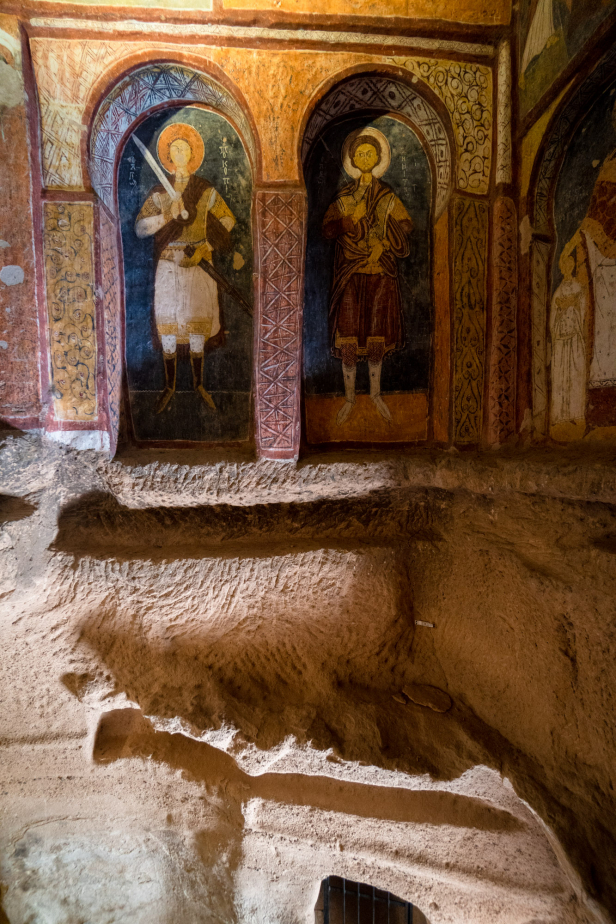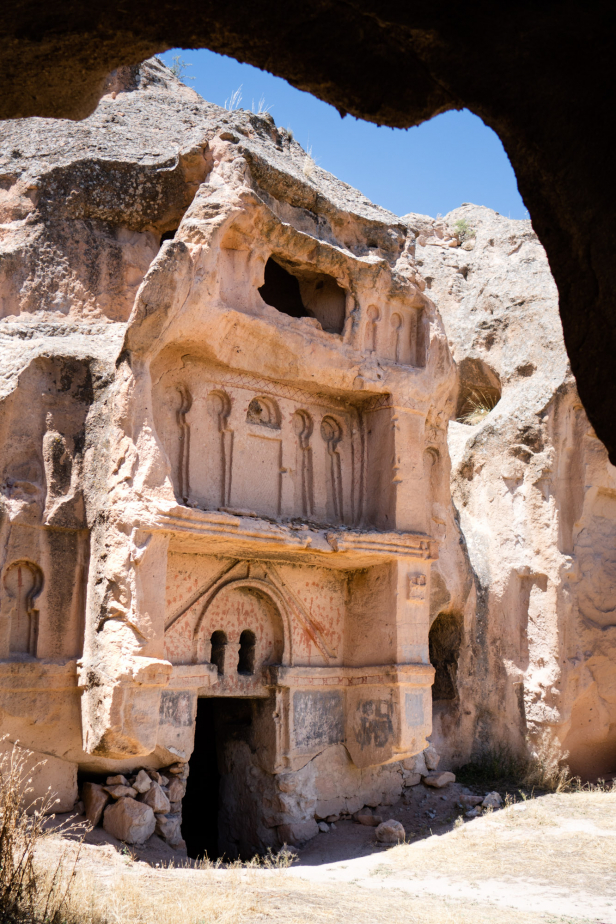Church of St Jean and the Town of Gülşehir
/ By Josh
Known today as Gülşehir or “Rose City”, this Cappadocian town has gone through many name changes over the millennia. Home to Hittite, Greek, and later Byzantine civilization it was known as Aravissos, Zoropassos, and later Arapsun before getting its current name. While there is history within the town, the 18th century Seyit Mehmet Paşa Mosque complex for example, most visitors come to Gülşehir to visit the quintessentially Cappadocian sites on its outskirts.
Subscribe to The Art of Wayfaring
Why Visit?
St Jean / St John Church
(Karşı Kilise)
Cost: 20TL
(Museum Card Accepted)
Before looking at this stunning church, a note about the name. The signs on site name this church as the church of St Jean and most other guides follow suit while some others use the name St John. The Greek Iwavvns is almost always translated to the English John, though for some reason this church on the edge of Gülşehir, has become known by the French St Jean. The Turkish is Karşı Kilise, meaning “the Church on the Other Side”.
The Church of St Jean / St John at Gülşehir is a stunning hidden gem of Cappadocian art and a rather unusual example of experimental architecture that evolved over time. Carved into a flat cliff of Cappadocian tuff (a stone formed by the hardening of volcanic ash), the church is set behind a simple façade of shallow niches with horse-shoe arches. The lower portion of the façade has been damaged and covered with a layer of plaster to keep it from falling into further disrepair (a similar layer of mortar was added to the upper portion of the stone on the east side to reduce water penetration).
Behind this façade there are actually two very different churches, one built on top of the other. The lower church, thought to date to the 10th or 11th centuries, is carved to a cruciform floorplan and decorated with simple red tracery, crosses, and child-like renditions of animals.
Subscribe to The Art of Wayfaring
The upper church was carved too close to the ceiling of the lower and has caused the floor/ceiling to collapse in the western portion of the nave as well as the central dome. The church clearly continued to be used after the collapse and you can see notches in the walls where beams had been set to make a new floor.

The upper church (dated to the 13th century) is remarkably different from the lower, the space filled with vibrantly coloured frescoes thanks to restoration work that removed heavy soot in 1995. Architecturally, the upper church is a simple barrel vault with an apse and a pair of niches (the pillars that formed the niches have since broken off) in the east wall.

Apart from the damaged section in the dome of the apse, the entirety of this upper church is covered in frescoes. The paintings mostly depict Biblical scenes from the life of Christ, though there are depictions of saints, church donors, and a rather striking scene from Revelation with a pair of figures riding a yellow dragon. Along the spine of the vault are seven Old Testament prophets; the two wearing crowns at the bottom are King David and King Saul.

St Dimitrios Greek Orthodox Church
(Aziz Dimitrios Rum Kilisesi)
Cost: Free
(The key can be found at the corner store across the street)
While Cappadocia is best known for its ancient cave churches, Gülşehir is home to a more modern church as well. The late 1800s saw a relaxing of the laws regarding religious minorities building places of worship (see the “Grape Church of Derinkuyu for another example). Included in this wave of church construction is the church of St Dimitrios, built in 1896 in the late-Greek basilica style.
The church was named for St Dimitrios, the Myrrh Bearer, or more literally “Myrrh Gusher”. In 303 AD, the first year of the Diocletian Persecution, Dimitrios was imprisoned for being a Christian. While imprisoned Dimitrios blessed a fellow Christian who was to be sent out to be killed in the arena. After being blessed by Dimitrios, the youth went out and wrestled his opponent and killed him. The gladiator was a favorite of a Roman general who was enraged and had Dimitrios killed. According to the legend St Dimitrios bled Myrrh as well as blood which earned him his epithet.
Subscribe to The Art of Wayfaring
The Church of St Dimitrios is built as a basilica church with three apses in the east wall. The interior is made up of three high, vaulted, aisles on two rows of pillars. There are only eight pillars; the remaining four required for the customary twelve (twelve being the number of Christ’s disciples: the “pillars” of the church) perhaps being included in the east and west walls. The church is topped by a high dome with windows in the drum to allow light inside.
What had originally been a covered porch on the western end of the church was later closed in to form a narthex, though its possible this change was made after the abandonment of the Church of St Dimitrios. Built in 1896, The Church of St Dimitrios in Gülşehir would only be in use for a few decades as by 1924 all the Greek Christians had left for Greece and been replaced by Muslims emigrating from Greece.
Açıksaray / Open Palace
(Açıksaray)
Cost: Free
(There is an abandoned ticket gate at the entrance that could be in use at a later date)
On the outskirts of Gülşehir is Açıksaray, a set of palacial complexes set behind ornate facades. Meaning “Open Palace” in Turkish, Açıksaray is easily accessible, vast, and just off the beaten track meaning that you can explore in peace even during high season. The site consists of nine “palace” complexes carved into the cliffs of a shallow stream valley. Even though the design of these complexes are quintessentially Cappadocian (See Belha Monastery and the surrounding complexes at Çanlı Church for other examples), the fact that the area consists of these large palace like complexes exclusively is quite strange and its purpose and history have remained a mystery.

Açıksaray is such a good site that we’ve writen a seperate guide. For more, check out Açıksaray, The Rock-Cut Complexes of “Open Palace”.
How To Get There
Public Transit/Taxi
Set along the Nevşehir – Kırşehir highway there is good public transit to Gülşehir. If you’re planning to visit Açıksaray you can either get off the bus on the side of the highway or take a taxi from Gülşehir itself. Another option in any of the tourist towns of Cappadocia is to arrange for transportation with a local travel agency who will hire a shuttle for you at an agreed upon price.
The Church of St Dimitrios is in the center of Gülşehir at the corner of H. Ali Koçak and Cami Streets and easy to reach by foot.
For more about busses and public transit check out our guide to getting around Turkey.
Car
If you’ve got your own car then Gülşehir is an easy desination to get to. The St Jean’s Church and Açıksaray are on the edge of town (St Jean’s is on the south side of the highway on Sururi Hoca street, while Açıksaray is on the south side of the D765 Nevşehir – Kırşehir highway, a couple kms out of town). The Church of St Dimitrios is in the center of Gülşehir at the corner of H. Ali Koçak and Cami Streets. Gülşehir is 16 kms north of the City of Nevşehir.
For more about car rental and driving in Turkey make sure to read our full drivers guide.
Where To Stay
This is Cappadocia so we’re not even going to attempt to put together an exhaustive list of hotels. In the countryside you’ll find scattered boutique hotels that offer you a chance to spend a night in the midst of Turkey’s agricultural landscapes. If you’re looking to stay in a cave hotel, sleep amid the stunning fairy chimneys of Cappadocia, or wake up to hot air balloons floating overhead, then the towns around Göreme (Üçhisar, Ortahisar, Ürgüp, Göreme) are your best bet. The city of Nevşehir is home to most of the large up-scale hotels though there are some in Göreme as well.
Other Tips
Planning on visiting St Jean’s Church in Gülşehir? Make sure to check out our other guides to the stunning sights of Cappadocia and the rest of Central Turkey!
Subscribe to The Art of Wayfaring
Have any tips or info to add? Spot any mistakes? We’d love to hear about it.



